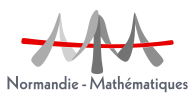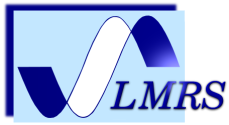Atelier des doctorants du vendredi 10/01/2020
Sur les intégrales stochastiques relativement au mouvement brownien fractionnaire.
Mots clés: Le mouvement brownien fractionnaire, intégrale de Wiener, divergence intégrale.
Sur les intégrales stochastiques relativement au mouvement brownien fractionnaire.
Mots clés: Le mouvement brownien fractionnaire, intégrale de Wiener, divergence intégrale.
Approche bayésienne pour la sélection du paramètre de lissage dans l'estimation de la densité par noyau circulaire
Almost periodically unitary solution to semilinear stochastic differential equations
Introduction à l'informatique quantique
The aim of this talk is to present the general ideas behind the concept of quantum computing, from its basic principles to the recent achievement of quantum supremacy. The presentation will be organized into two parts:
Billiard flow in nibbled ellipses
I plan to present some basic properties of the billiard flow on nibbled ellipses. The boundary of a
nibbled ellipse consists of a chain of elliptic and hyperbolic arcs, all coming from confocal conics. The
main aim of the talk is to present some steps and tools in the proof of equidistribution of billiard orbits
for almost all invariant sets determined by caustics of the billiard.
Trier des clés: une analyse en moyenne du nombre de comparaisons de symboles
On aborde classiquement l'analyse en moyenne d'algorithmes en s'intéressant à la complexité mesurée en nombre de comparaisons. On a alors des résultats de complexité du type « tel algorithme est en $O(n \log n)$ en moyenne » (par exemple Quicksort pour citer un des plus connus).
Le quintet de la depoissonisation Rice-Poisson-Mellin-Newton-Laplace
Le processus de Dépoissonisation est central en analyse probabiliste des structures combinatoires et des algorithmes.
Il est souvent beaucoup plus facile d’effectuer les analyses dans le modèle de Poisson (où la taille des données suit une loi de Poisson),
mais on désire revenir ensuite dans le modèle usuel où la taille des données est fixée (puis tend vers l’infini). Ce « retour » est appelé dépoissonisation.
La stabilité linéaire dans le modèle de Soler
Le but de mon exposé est de présenter quelques aspects de l'analyse que nous avons faite avec Andrew Comech sur la stabilité des ondes solitaires d'une équation de Dirac non linéaire : le modèle de Soler. Notre travail s'est principalement concentré sur la question de la stabilité linéaire. Les résultats que nous avons obtenus laisse espérer que le modèle est asymptotiquement stable.
Modèles diffusifs de mélanges gazeux, dérivation à partir de la théorie cinétique
Dans cet exposé, j'évoquerai les lois de Fick et Maxwell-Stefan pour la diffusion gazeuse, puis présenterai la dérivation du second modèle en me plaçant dans l'asymptotique diffusive de l'équation de Boltzmann.
 Le LMRS est l'une des composantes
Le LMRS est l'une des composantes
de la Fédération Normandie-Mathématiques.
© 2026, Laboratoire de Mathématiques Raphaël Salem
